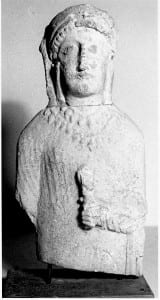

From the Collections of the Center for Old World Archaeology and Art
Brown University
Providence, RI (USA)
Limestone, 5th century. Gift of Richard Wagner.
_________________________________________
Derek B. Counts (University of Wisconsin-Milwaukee)
Upon close examination, one immediately notices the flawed restoration of this enigmatic statue which matches the male head, enveloped in a lion-skin, with a female torso. The two fragments are joined together by a granular, thick adhesive (cement?). It would appear that the head fragment was intentionally cut at the neck to create a ‘fit’ to the torso. The head is from a statue of Herakles and the torso belongs to a draped female votary; both types are common in Cyprus in the late 6th and early 5th c. BC. Because Cyprus lacks an indigenous source of marble, votive statues were sculpted in a local limestone which is especially abundant along the skirts of the Central-Eastern plain of Cyprus known as the Mesaorea (“between the mountains”). The majority of extant limestone statuary comes from this part of the island where the important sanctuaries of Idalion, Golgoi-Ayios Photios, Tamassos, Arsos and Kition have been identified. The back of the statue is unworked, characteristic of the generally shallow modeling of Cypriote limestone statuary (see also, profile view above). This phenomenon can be explained as a result of the limitations inherent in the stone itself (which tends to produce thin slabs when quarried) or as result of its intended display against the walls of the sanctuary and its buildings.
The Head of Cypriote-Herakles
The head (seen here in an oblique view) of the Brown statuette is originally from a figure of the so-called Cypriote-Herakles type. It is covered with the skin of a lion of which the eyes and nose are discernible, as well as the upper jaw across the forehead and the lower jaw split to frame the face. There is evidence of applied red pigment, especially on the lips of the figure and parts of the lion headdress. Paint was a common feature of Cypriote stone sculpture.
The Cypriote-Herakles type enjoyed wide-ranging popularity in the Mesaorea Plain at major religious/civic centers such as Kition, Golgoi, and Idalion as well as in the rural sanctuaries of the area; it is virtually unknown in the western part of the island. The iconography of Herakles first appears in Cyprus in the 6th c. BC, and from the late 6th c. BC until the end of the 4th c BC, a relatively consistent and widely diffused type occurs. Often referred to as the Combatant God, this type combines various aspects of typical Greek iconography cast within the guise of the Near Eastern Master of Lions. The god stands upright; in the right hand he raises a club which is attached to the back of the head and, in the left hand, holds a petite totem lion against the left leg. The figure’s head is enveloped by a lion-skin; the open mouth of the lion frames the face with the lower jaw split to either side. The remainder of the skin falls down the back of the figure, with the front paws draped over the shoulders and tied at the chest in a characteristic “Herakles Knot”; the hind legs continue down the back side terminating at the calves of the figure where the paws are shown attached. The broken club is clearly visible attached to the back of the Brown head .
The iconography and material, as well as the facial features (flat, almond eyes and pursed, almost frowning lips) of the Brown head suggest a date within the second quarter of the 5th c. BC and an origin somewhere in the Mesaorea Plain, possibly Idalion or Kition.
Draped Torso of Female Votary
The Brown torso of this pastiche was originally part of a limestone statuette of a female votary. The figure wears a tight-fitting, ribbed tunic which is covered by a mantle extending from the proper left shoulder across the body and around the right hip. She carries a traditional votive which, although weathered, is most likely a flower, possibly a lotus. As opposed to contemporary male votive statues, female representations in limestone from the Archaic period (beginning sometime at the end of the 7th c. BC) onwards present a rather limited typology. Although slight variations sometimes occur in the drapery, the standard frontal pose with a votive (fruits, small animals, flowers) held close to the chest in either the right or left hand is most common. Also characteristic of the female statues from Cyprus is the abundant use of decorative jewelry that usually incorporates earrings and necklaces consisting of large pendants as seen on the Brown University torso. These statues (most of which are under life-size) have been interpreted as representations of the “Great Goddess”, and it has been suggested that they reproduce cult images. It is just as likely, however, that they are simply representations of female votaries. Female votive statues such as the Brown torso occur all over the island making it difficult to establish any secure provenance, even at the regional level. Stylistically this piece should date towards the middle of the 5th c. BC.